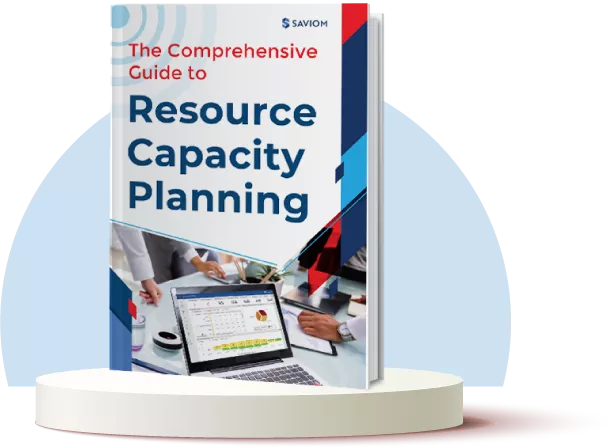A business’ organizational structure plays an integral part in defining its growth, employee productivity, and overall operational efficiency. Therefore, many organizations have evolved and adopted a matrix management structure that allows interdepartmental collaboration and fosters a shared services model.
This also helps reduce unnecessary hiring costs, improve project delivery, enhance business operations, and thrive in the competitive business landscape.
Matrix management promotes the sharing of resources across boundaries and stands out for its adaptability and flexibility.
This blog explains the nitty-gritty of matrix management structure, its advantages and disadvantages, and how to implement it in your organization effectively.
But first, let’s define matrix management.
What is Matrix Management?
Matrix management is an organizational structure that allows employees to have multiple reporting lines. In other words, employees could have a dashed line reporting to one manager and dotted lines to one or multiple managers.
For instance, the two main chains of command within matrix management are the project managers and the line managers. While employees report to the project manager for their work responsibilities, they report to the department manager or line manager for their day-to-day operations, leave approvals, and performance appraisal.
It is an ideal strategy for any company that works on multiple projects with similar or overlapping skill requirements.
Now that we understand the definition and matrix organization example, exploring the different types is important to determine which is most beneficial for your firm.
Types of Matrix Management
There are three types of matrix management structures based on the degree of authority and influence between the functional/line and the project managers.
Let’s understand them in detail.
Weak Matrix
A weak matrix structure is similar to the traditional hierarchical work environment, wherein the line manager has the highest level of authority, and the project manager has limited control. The line managers oversee the entire project and make most decisions regarding the budget, resource allocation, scheduling, task delegation, etc. Conversely, the project manager has a restricted role of coordinator or expeditor.
Balanced Matrix
The balanced matrix strikes a middle ground between weak and strong matrix structures. In this arrangement, the line and project managers share authority and power relatively equally. Here, the project managers determine the skills required for a project, whereas the line managers allocate the resources to meet those needs. Team members keep both managers informed about their work progress.
Strong Matrix
In a strong matrix, the project manager has higher authority and control over the resources than the line/functional manager. In addition to that, they have significant decision-making power and control over resource allocation, task distribution, etc. Further, they function as the primary supervisor for employees, while the line managers take on a more secondary role.
Now, let’s go through the various roles and responsibilities within a matrix organization.
Roles and Responsibilities within a Matrix Management Structure
Let’s read about the most prominent ones.
Matrix Resources and Matrix Teams
In a matrix-based organization, individuals functioning within this structure are referred to as matrix resources, while a collective group of such matrix employees forms a matrix team. These individuals possess specialized expertise and multiple skill sets that different departments leverage to execute various projects. As a result, they typically report to their project managers and their respective line managers.
Functional Managers
In a matrix organization, functional managers (aka project managers) are responsible for overseeing specific functions or projects. Throughout a project’s life cycle, they collaborate with resource managers to onboard or release personnel as needed. Once resources are allocated to a project, the functional manager oversees their day-to-day activities and resources have a dotted reporting line to the functional manager.
Line Managers
In a matrix organization, every resource has a solid reporting to a line manager/ departmental manager. They are also known as people managers and perform tasks like performance appraisals, salary adjustments, and training plans. However, they are not responsible for the everyday activities of their direct reports (DRs). Instead, they gather performance feedback from the functional managers to make informed decisions.

How Does a Matrix Organization Work?
A matrix organization is designed to support a shared-services model where resources can be deployed across various projects based on the skill set, irrespective of the department or team they belong to.
For instance, a graphic designer belonging to a design department is permitted to take up a role within another department running a web development project. In this case, the designer resource will be allocated to this new project and report directly to the project manager overseeing the specific initiative.
This helps break down silos and foster cross-functional collaboration. Additionally, the shared resource pool reduces the costs of hiring new candidates with similar skills and optimizes overall resource utilization.
Another prime matrix organization structure example is PHILIPS, a renowned Dutch electrical giant that was one of the forerunners in implementing a matrix organizational structure after World War II. Their structure was based on geographical area and worldwide product divisions.
This means an employee will report to their regional manager (specific to their location) and the product divisional head (the product portfolio they are a part of). However, it has evolved over time to overcome the limitations. Though the functioning sounds straightforward, the operational complexity increases when multiple projects simultaneously demand the same competencies.
Now, let’s understand the advantages of matrix management structure.
Read more: Effective Ways to Overcome Resourcing Challenges in Matrix Organizations
Benefits of Matrix Management
Matrix structure enables organizations to overcome the limitations of traditional hierarchical structure and excel in a competitive market by fully harnessing their workforce’s potential.
Let’s understand its benefits in detail.
Helps Leverage Cost-Effective Resources
A matrix organizational structure enables resource managers to go beyond regional boundaries and leverage cost-effective resources.
If a resource is beyond their span of control, they coordinate with other resource managers to procure the best-fit resource at a much lesser cost. This prevents project budget overruns and ensures profitability.
For instance, let’s assume a project is based in the US, where the resource cost is higher. A matrix structure enables the manager to look for similarly skilled resources from a low-cost country and control project costs without compromising quality.
Facilitates Effective Utilization of Resources
Matrix management supports a shared services model, enabling employees to utilize their skills on multiple projects simultaneously. For example, a highly skilled resource working on Project A can also contribute to Project C based on availability. This enhances their profitable utilization while reducing resourcing costs.
Furthermore, if resources are under-utilized, resource managers can provide suitable work by allocating them to different projects (interdepartmentally). These practices ensure uniform workload distribution and optimal utilization of the talent pool.
Read more: What is Resource Utilization and its Significance?
Enables Multi-skill Building at the Workplace
Matrix managers encourage multi-skill building opportunities and create individual development plans (IDPs) as per resource requirements. For instance, if a graphic designer’s primary skill is Adobe Photoshop, CorelDraw is a secondary skill, a pipeline project requires two designers with CorelDraw skills, but only one is available.
In this case, the resource manager can coordinate with the line manager to initiate a suitable training program to enhance the designer’s CorelDraw skills. This helps mitigate skill gaps, fulfill project demands within budget, and enables employees to learn new skills, making them more valuable.
Promotes Knowledge Sharing Across Various Functions
Matrix management fosters an open work environment, encouraging interdepartmental coordination and knowledge-sharing. For instance, let’s say your team of web developers, graphic designers, content writers, etc., are working on a website development project.
Since the website has a design component, the graphic designer can share the latest technology trends and insights with the web developer and vice versa. This seamless collaboration will help all to enhance their knowledge and deliver quality projects within time and budget.
Read more: How to Manage Resources in Agile Project Management?
Now, let’s explicitly understand the difference between matrix management structure and traditional hierarchy.
Matrix Management vs. Traditional Hierarchies
| Aspect | Matrix Management Structure | Traditional Hierarchies |
|---|---|---|
| Reporting Structure | Employees have multiple reporting lines. They report to both the functional manager and project manager simultaneously. | Employees have a single reporting line. They report to their immediate supervisor or department head. |
| Project-based Focus | Projects serve as the primary organizing principle, with teams formed to address specific goals and objectives. Employees bring their functional expertise to contribute to project success, allowing for a multi-disciplinary approach. | They are typically organized based on functional departments, where employees focus primarily on their functional responsibilities rather than project-specific goals. |
| Skill Development | There is greater emphasis on skill development as employees work in cross-functional teams and participate in diverse project tasks. They must have a broader range of skills and competencies. | Such structures follow a specialized approach to skill development where employees hone their skills within a specific area, with limited exposure to tasks beyond their defined roles. |
| Adaptability to Change | Matrix teams can be assembled and disassembled quickly to respond to changing project needs. This makes them more flexible and adaptable to dynamic market conditions. | With their more rigid structures, traditional hierarchies struggle to adapt swiftly to changes due to their fixed departmental setups and reporting lines. |
Now, let’s understand the disadvantages of matrix management model in an organization.
Disadvantages of Matrix Management Model
While matrix organizations offer numerous benefits, they also have potential disadvantages that must be addressed effectively.
Let’s explore these challenges in detail:
Silos of Information
Due to the intrinsic nature of matrix organizations where employees report to multiple managers and work across various projects, communication can become fragmented. This often leads to information silos. Additionally, reliance on legacy tools or spreadsheets can further exacerbate the issue.
Read more: 7 Reasons Why You Shouldn’t Use Excel for Resource Planning
Ambiguity in Managerial and Team Roles
The dual-reporting structure in matrix management can create ambiguity regarding managerial and team roles. Employees may lack clarity about their reporting managers. On the other hand, when managers oversee a sizeable interdepartmental team, they often fail to communicate goals and expectations effectively. As a result, employees struggle to understand project priorities and their responsibilities.
Scheduling Conflicts
Sometimes, there are situations where two project managers require the same resource simultaneously. However, without real-time visibility into work schedules, resource managers may inadvertently double-book the resource. This scheduling discrepancy leads to overallocation, resulting in lower productivity and burnout.
Read more: What is Resource Scheduling? How to Schedule Resources for Projects Efficiently?
Difficulty in Evaluating Employee Performance
Since employees report to multiple managers in a matrix structure, gathering consistent and comprehensive feedback is challenging. Disparities in performance evaluations from different managers can confuse and impede fair assessments. It can impact career development, promotions, and compensation decisions.
Now, let’s grasp the essential steps to implement an effective matrix structure within your organization.
Steps to Implement Matrix Management in the Organization
Implementing an effective matrix organizational structure requires meticulous planning and execution to ensure a seamless transition.
Here are the key steps firms should take:
Get Stakeholder Buy-in for Transition
The first crucial step in implementing matrix management is to secure stakeholder buy-in. This involves conveying the strategic rationale behind the change and engaging the stakeholders in open dialogue to address concerns and build support.
Once the executives and top-level management have reached a consensus, they must actively promote its adoption to ensure a smooth transition and minimize employee resistance. That’s because leadership support sets the tone for the entire organization and helps create a culture that embraces matrix management principles.
Read More: The Fundamentals of Leadership in Project Management
Establish SMART Objectives & Goals
Setting SMART (Specific (S), Measurable (M), Achievable (A), Relevant (R), and Time-bound (T)) objectives and goals in matrix management is vital for aligning diverse teams and ensuring clarity in tasks. Each objective and goal must be clearly defined, measurable, and achievable within a specific timeframe.
This enables team members to understand their contributions to the overall project and organizational goals, irrespective of their functional area. It also promotes focus and direction, allowing individuals to track progress and make necessary adjustments to meet those goals.
Clearly Define Employees’ Roles and Responsibilities
Defining and structuring employees’ roles and responsibilities is essential in matrix management to avoid confusion and internal conflicts. It includes outlining the balance between functional roles and project-based responsibilities.
Moreover, with better clarity of reporting structure and the nuances of each role, resources display greater accountability for their work performance. Therefore, it reduces potential role conflicts and fosters better productivity within the matrix structure.
Read more: What is PMO: Roles, Responsibilities, Types & Benefits
Establish Standardized Protocols for Communication
Establishing effective communication strategies ensures that critical information flows freely across matrix boundaries. Therefore, matrix managers must leverage synchronous and asynchronous modalities to foster cross-functional team collaboration.
Moreover, they can set up standardized protocols for each modality to reduce unnecessary meetings or miscommunication. Further, open communication can help align team efforts with overall organizational goals. It also enables seamless conflict resolution and maintains a shared understanding of priorities.
Offer Comprehensive Training to Employees
To ensure a smooth transition to matrix management, organizations should provide comprehensive retraining/upskilling and multi-skill-building opportunities. These programs equip resources with multiple competencies, allowing them to expand their roles and responsibilities within the organization.
Moreover, it allows matrix companies to deliver more projects with fewer resources. Therefore, by investing in employee development, organizations can build an agile workforce that adapts easily to changing market conditions.
Read More: How Can Retraining/Upskilling Future-Proof Your Workforce?
Assess the Efficacy of Matrix Structure Periodically
An ongoing evaluation mechanism can be key to the long-term success of matrix management. It helps firms regularly assess the effectiveness of the matrix structure. It can involve soliciting feedback from employees, measuring key performance indicators, and conducting regular retrospection.
As a result, it allows organizations to address potential issues and refine internal processes. In conclusion, continuous improvement efforts enable firms to optimize the benefits of matrix management and enhance overall performance.
Next, let’s understand how resource management software can help a matrix organization.
How can Resource Management Software Foster Effective Matrix Management?
A comprehensive resource management software can help matrix organization function smoothly. It can help them overcome the complexities and challenges of such a structure.
Here’s how:
- Enterprise-wide visibility- The tool provides 360-degree visibility, enabling matrix managers to identify and allocate competent resources to multiple projects across organizational boundaries.
- Advanced filters- The advanced filters allow managers to oversee and manage a geographically dispersed workforce. It enables them to sort and identify cost-effective global resources based on skills, competencies, and other parameters.
- Competency matrix- The competency matrix helps managers identify suitable candidates for training/upskilling, IDP, and succession planning.
- Automated resource requisition workflow- The automated resource requisition workflow can minimize power conflicts between different matrix managers. Additionally, it helps maintain an audit trail that keeps all the stakeholders in the loop, thereby promoting transparency.
- Forecasting & Capacity planning- The powerful forecasting and capacity planning feature helps matrix firms foresee pipeline project demand and identify resource shortage/excess in advance. It gives managers enough lead time to implement appropriate treatments to bridge the gap.
- Resource Scheduling- The tool’s multi-dimensional scheduler helps managers get insights into resource schedules and adjust as required. This enables them to eliminate scheduling conflicts and ensure seamless project delivery every time.
- Real-time BI reports- Real-time BI reports such as forecast vs. actuals, project vacancy, color-coded heatmaps, utilization reports, etc., come in handy when monitoring various resource KPIs such as resource utilization, availability, etc.
- Collaboration tool- The software has an in-built collaboration module that allows resources and managers to communicate and share project updates.
- What-if analysis- This simulation and modeling functionality enables managers to prioritize profitable assignments in a multi-project environment. Thus, it helps prevent internal conflicts and power struggles.
Read more: How Can You Make Data-Driven Decisions with Resource Management Software?
Conclusion
The rise of globalization and increasing cost pressures have made it imperative for companies to go beyond their conventional management strategies and switch to a matrix structure. It enables firms to leverage skilled resources across different projects, departments, and functional areas, which ultimately helps boost business efficiency and profitability. The benefits listed above will convince you to redefine your organizational structure into a matrix environment.
So, are you ready to adopt the matrix management strategy?
The Glossary
Read more: Glossary of Resource Workforce Planning, Scheduling and Management
The SAVIOM Solution
SAVIOM is the market leader in helping multinational clients manage their resources efficiently and effectively. With over 20 years of experience, this Australian-based MNC has a global presence across 50 countries and has helped 100+ clients with their Workforce Planning Software. Saviom also provides tools for Enterprise Project Resource Management, Project Portfolio Management, and Professional Service Automation. Boost your remote team collaboration with Saviom.











